Russian wheat aphid
Diuraphis noxia
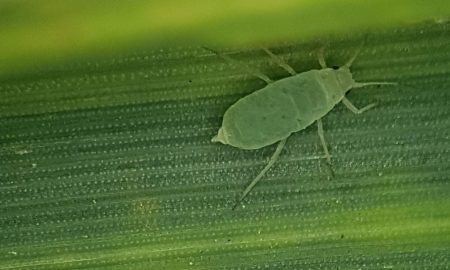
A Russian wheat aphid adult. Note the lack of apparent siphunculi and short antennae. Photo by Elia Pirtle, Cesar Australia
Summary Top
Russian wheat aphid (RWA) is one of the world’s most economically important and invasive pests of wheat, barley and other cereal grains. Since first being discovered in South Australia in 2016, RWA has been found widespread in cereal growing regions of South Australia, Victoria, New South Wales and Tasmania. Their small size, green colour, elongate shape, very short antennae and apparent lack of siphunculi readily distinguish RWA from other pest aphids found in Australian cereal crops. Russian wheat aphid injects salivary toxins during feeding that cause rapid, systemic phytotoxic effects on plants, resulting in acute plant symptoms and potentially significant yield losses.
Occurrence Top
Around the world, the distribution of RWA is primarily associated with cereal production regions characterised by relatively warmer, drier climates. It is less prevalent or nonexistent in higher rainfall areas. It is native to southern Russia, the Middle East and Central Asia but since the late 1970s and early 1980s, has rapidly spread to other major grain producing regions in Europe, Africa, North America and South America.
Russian wheat aphid was first detected in Australia in May 2016, in an early sown wheat crop in the Mid North of South Australia. It has since been confirmed as widespread in cereal growing regions of South Australia, Victoria and New South Wales, and present in Tasmania. This species has a wide range of Graminaceous host plants including cultivated and wild grasses that occur widely throughout Australia. Russian wheat aphid has a history of successfully invading new regions, partly due to its widely available host plants and capacity for rapid population growth. Aphids could potentially disperse to new areas on contaminated plant material, on machinery and other equipment, or via dispersal of winged adults over large distances by wind assisted flight.
Description Top
The RWA is up to 2 mm in length, pale green in colour, elongate and spindle-shaped, often with a fine dusting of whitish wax. Apterous (wingless) adults have very short antennae, about 0.33 – 0.5 of body length, and very short siphunculi (‘exhaust pipes’), that initially appear absent to the naked eye. The alate (winged) adults have body-length antennae and are generally darker in colour with dusky colouration on parts of the body, particularly the thorax. They have two caudal processes (short tails) on the end of the abdomen, one above the other, giving the appearance of a ‘double tail’ under magnification (see image). Their general small size, green colour, elongate shape, very short antennae and apparent lack of siphunculi are characteristics that readily distinguish RWA from other aphids found in Australian cereal crops.

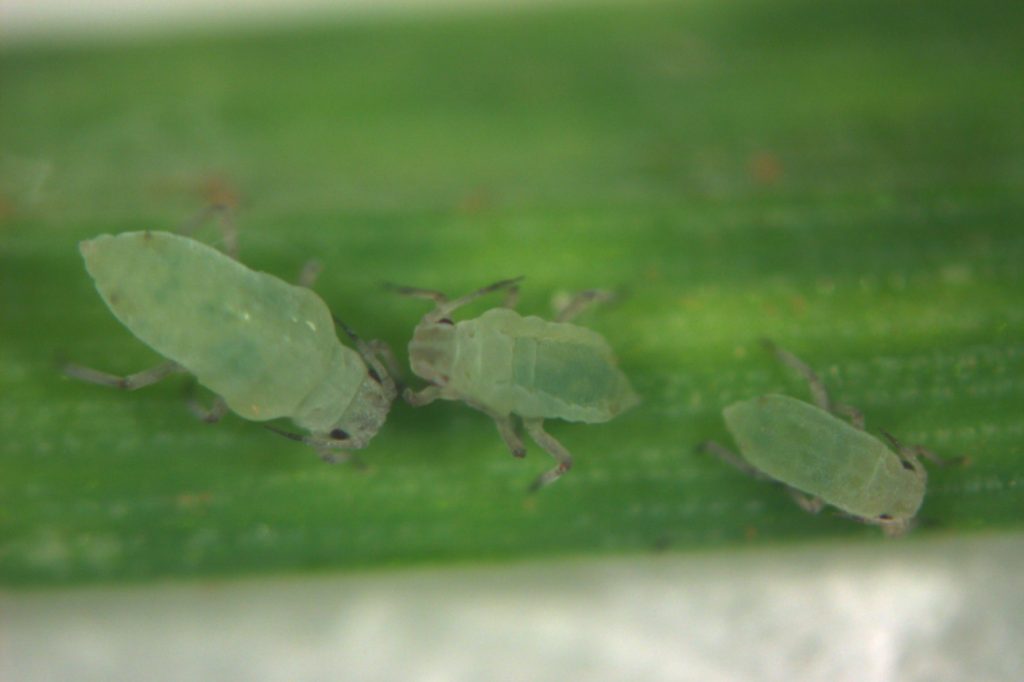
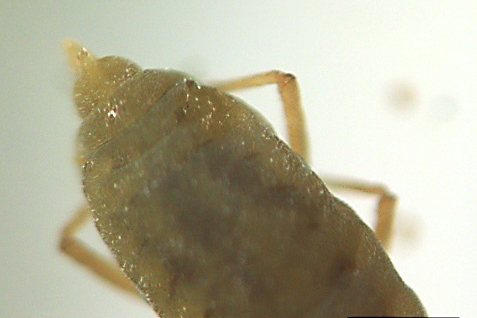
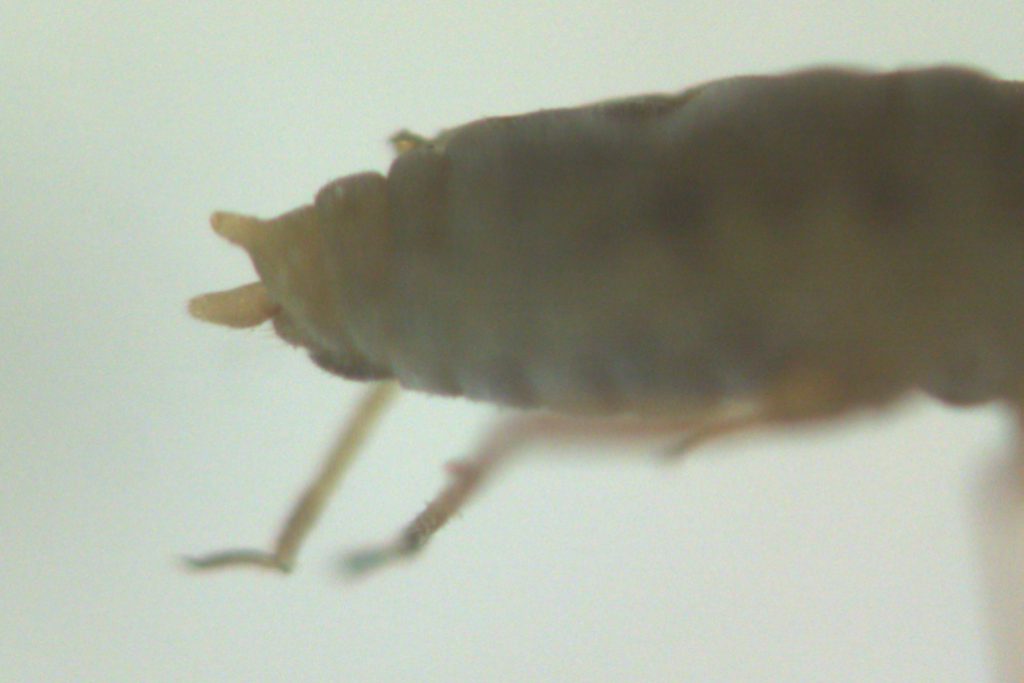
Their general small size, green colour, elongate shape, very short antennae and apparent lack of siphunculi are characteristics that readily distinguish RWA from other aphids found in Australian cereal crops.
Lifecycle Top
In its native range the life history of RWA includes sexual and asexual phases. However, like most other introduced aphid pests in Australia, invasive populations of RWA reproduce asexually with females giving birth to live female offspring.
In autumn, aphids may infest wheat seedlings soon after emergence, usually from wingless aphids walking off nearby senescing hosts. Russian wheat aphid requires actively growing plants for development. Population growth begins from tillering and stem elongation and becomes most rapid from booting onwards. Early in the crop cycle, the vast majority of aphids are wingless. Later in the crop cycle as aphid population density increases, the proportion of winged aphids increases and may reach high levels prior to ripening. At this stage, aphids emigrate in search of alternative summer hosts.
Russian wheat aphid is able to survive under a wide range of temperatures and may perform better at lower temperatures than other cereal aphid pests. However, higher temperatures (>25°C) may limit the distribution of RWA. Under laboratory conditions, generation time ranges from approx. 20 days at 10°C, and 9 days at 20°C.
Behaviour Top
Aphids regularly move by walking among leaves, tillers and plants. Percentage of infested plants increases during the crop cycle. Winged RWA are weak flyers, but can travel on wind currents efficiently enough for aphids to locate isolated host plants.
Similar to Top
Other cereal aphids, particularly rose-grain aphid in shape and colour, but can be easily distinguished by the apparent lack of siphunculi (‘exhaust pipes’)
Crops attacked Top
The host range of RWA includes more than 140 species of cultivated and wild plants within the family Graminae (grasses). These include wheat, barley, triticale, rye, oats, pasture grasses and wild genera including Poa, Bromus, Hordeum, Lolium, Phalaris and others. Wheat and barley are most susceptible, while triticale, rye and oats are less susceptible. In South Africa, native grasses apparently do not host RWA.
Damage Top
Aphids feed in dense colonies, typically at the base and sheath of younger leaves and within leaves curled lengthwise by their feeding. Aphids prefer to feed on the newest leaves of plants and are often found on the last two leaves unfurled. At high densities they can be found on any foliar parts.
Even few aphids can cause symptoms to appear as early as seven days after infestation. Damage symptoms are characterised by (also see images) longitudinal rolling of leaves, forming a hollow tube inside which aphids shelter; whitish, yellowish to pink-purple chlorotic streaks along the length of leaves. Heavily infested plants are often stunted and may appear flattened, with tillers lying almost parallel to the ground. Viewed from a distance, damage may appear as a general loss of colouration across the affected crop area. Later in the crop cycle, wheat awns may become trapped by rolled leaves resulting in a hook-shaped head, and bleaching, resulting in reduced yield. Economic damage is primarily caused by direct feeding, with little evidence of significant transmission of plant viruses where it occurs overseas.
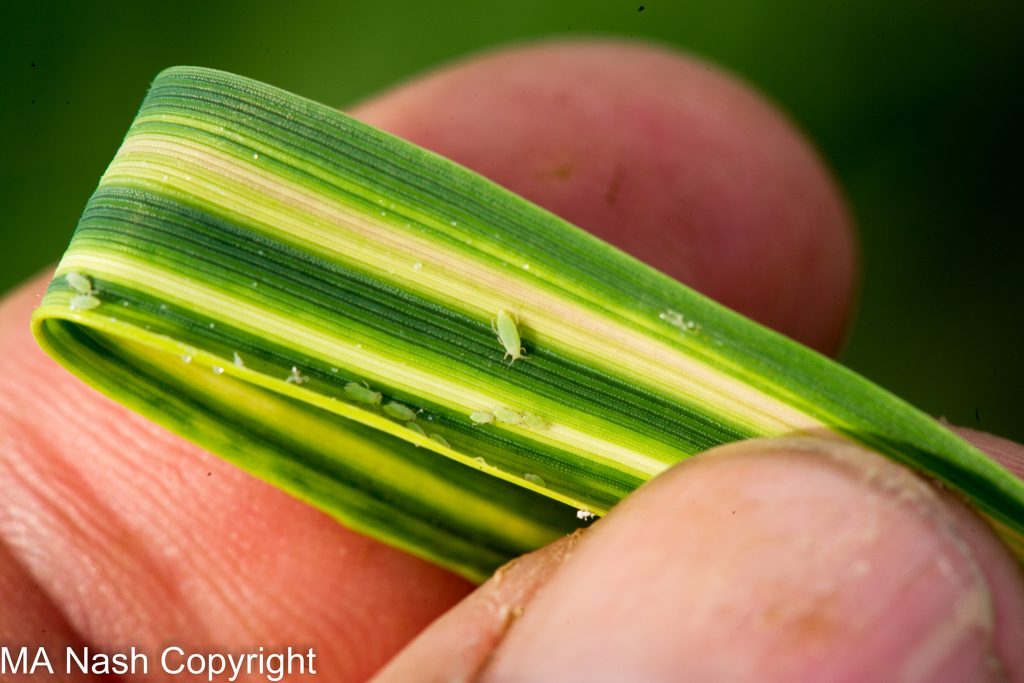
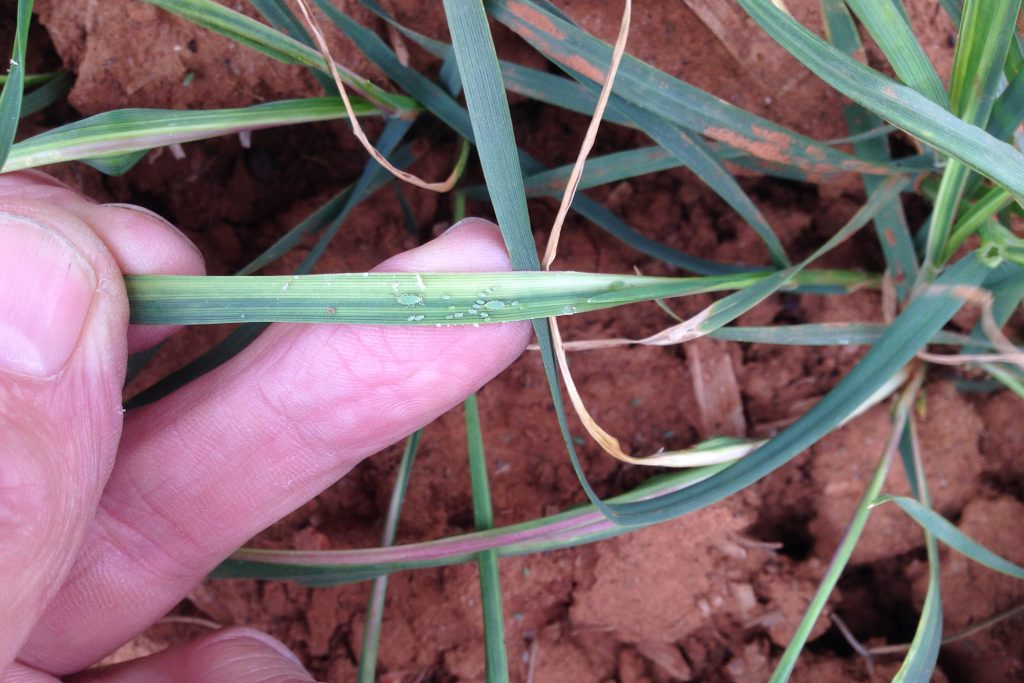
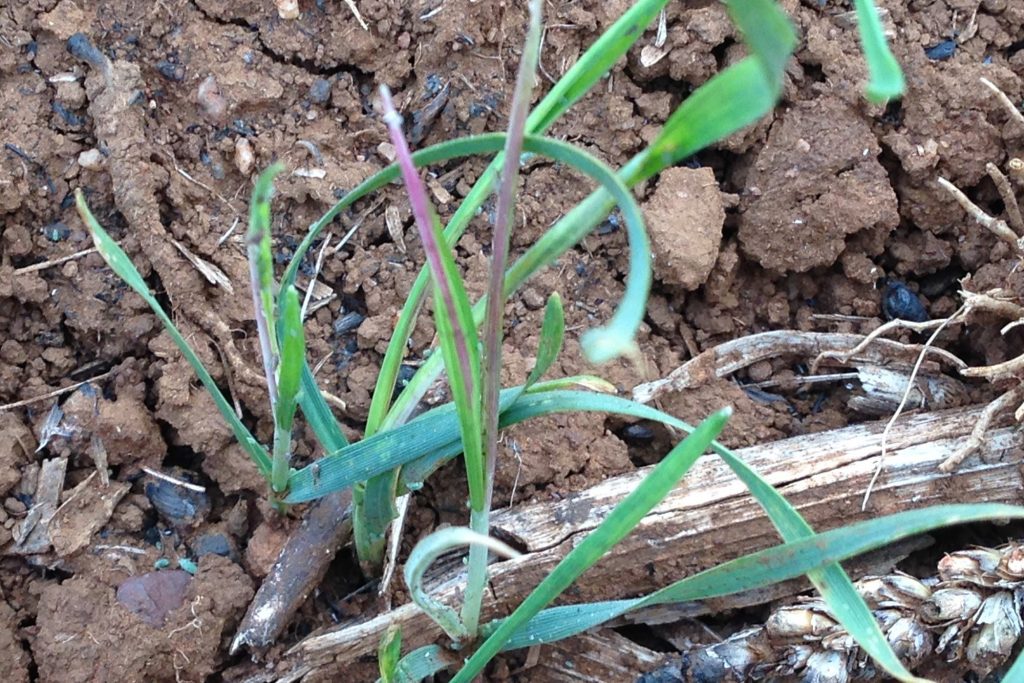
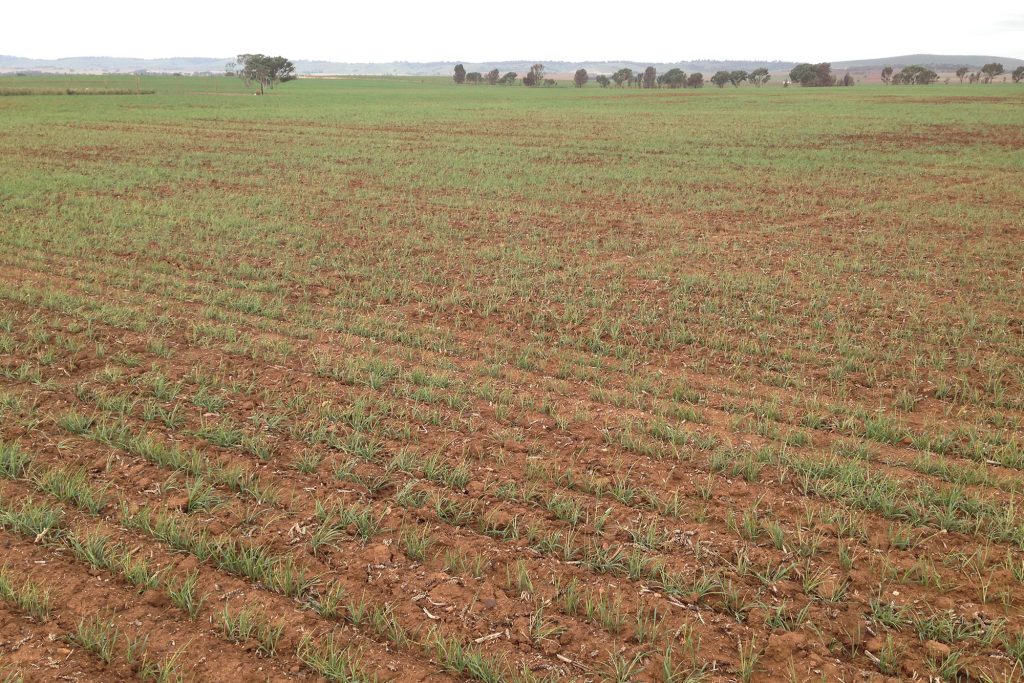
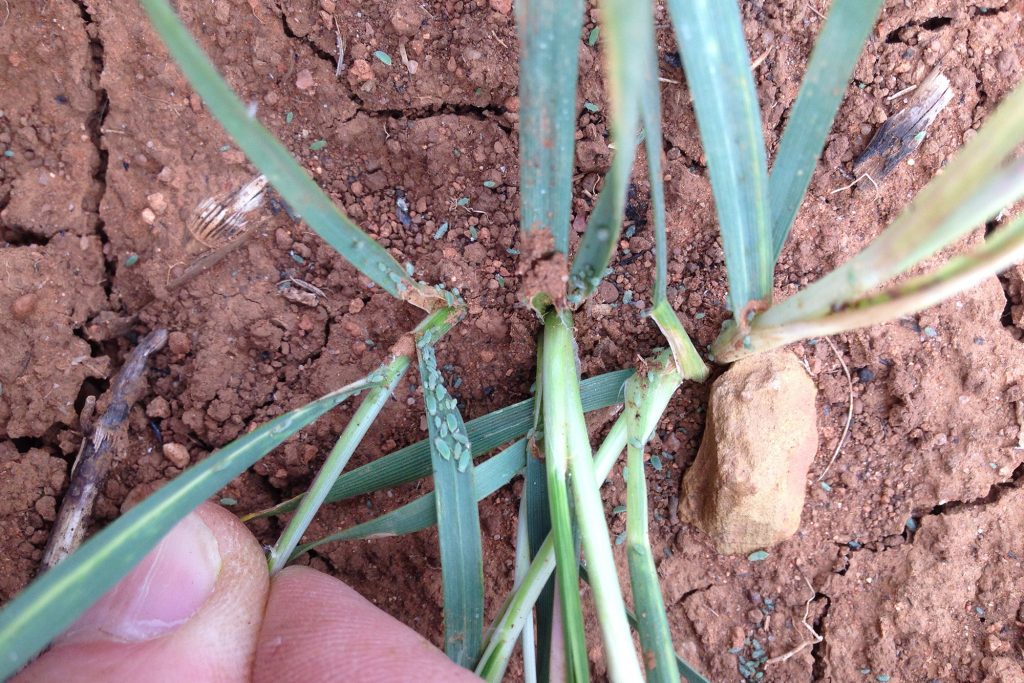
Damage symptoms are characterised by longitudinal rolling of leaves, forming a hollow tube inside which aphids shelter; whitish, yellowish to pink-purple chlorotic streaks along the length of leaves.
Monitor Top
The salivary toxins injected by RWA during feeding damages plant chloroplasts, resulting in reduced photosynthetic ability, delayed leaf initiation and tillering, reduced numbers of fertile tillers, shoot and root biomass, grains per ear and grain weight. Yield impacts are determined by the percentage of infested tillers and plants and crop development stage. Heavy infestations during early growth can cause serious damage. From early booting to soft dough stage, feeding on upper leaves, in the leaf sheath and next to the developing head, can cause direct yield losses. In wheat and barley, damaged leaf tissue does not recover. If aphids are controlled, new growth proceeds normally (new root and shoots are unaffected) and plants may recover unless excessively stressed. After soft dough stage, further impact is minimal.
Economic thresholds Top
Economic thresholds (ET) are yet to be established under Australian conditions but guidelines are available overseas. Guidelines from the United States vary somewhat between regions, but for early season growth, an ET of 20% seedlings infested up to the start of tillering, and 10% seedling infested thereafter, is recommended.
Management options Top
Biological
Russian wheat aphid is attacked by a range of natural enemies, many of which also attack other aphids. Of these, groups that commonly occur in Australia include the parasitoid wasps Aphidius colemani, A. ervi, Diaeretiella rapae and generalist predators including ladybird beetles (e.g. Coccinella spp., Hippodamia spp.), lacewings (Chrysopa spp.), damsel bug (Nabis sp.), hoverflies (Syrphus spp.), and also entomopathogenic fungi.
Like other aphids, populations of RWA are strongly regulated by environmental conditions. Survival of aphids outside the shelter of leaf rolls is affected by exposure to rainfall, drying winds, and predators and parasitoids. Rainfall often washes aphids from upper leaves and heavy rainfall may cause 50% mortality.
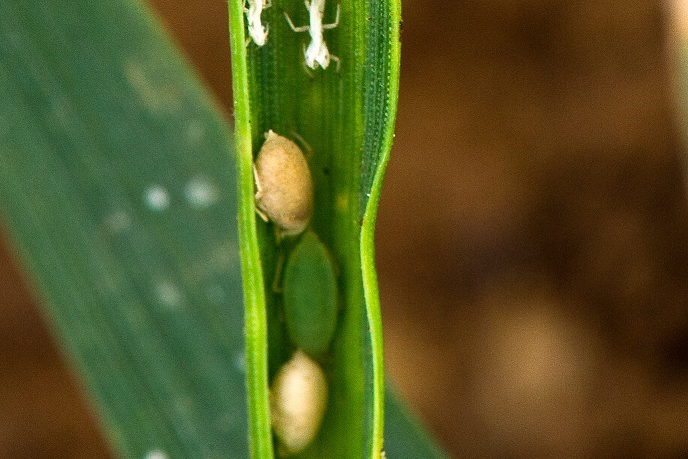
Cultural
In certain regions around the world, wheat cultivars with resistance to RWA are deployed. In some regions, ‘virulent’ aphid biotypes have developed that have overcome host resistance genes.
Cultural controls include eliminating refuge volunteer cereals and grasses in fallows and other areas during summer and autumn, later planting of winter cereals to delay and reduce early aphid infestation, and agronomic practices to promote crop vigour and dense canopy growth which inhibit RWA populations and reduces their impact on the crop.
Chemical
Chemical control of RWA is effective. Due to the cryptic feeding habits of RWA, complete coverage and use of an insecticide with fumigant or systemic activity is required. Organophosphate insecticides can be effective, but broad spectrum products have the side effect of destroying many natural enemies. Seed treatments offer some early season protection. Decisions on the need for foliar treatments are based on the proportion of seedlings or tillers infested.
Permits have been issued by the APVMA for use of imidacloprid seed dressing (PER82304), pirimicarb and chlorpyrifos (PER82792) against RWA in winter cereals. See individual permits for specific terms of use.
Acknowledgements Top
This article was compiled by Kym Perry (SARDI) and Bill Kimber (SARDI).
References/Further Reading Top
Bellati J, Mangano P, Umina P and Henry K. 2012. I SPY Insects of Southern Australian Broadacre Farming Systems Identification Manual and Education Resource. Department of Primary Industries and Resources South Australia (PIRSA), the Department of Agriculture and Food Western Australia (DAFWA) and cesar Pty Ltd.
Hughes RD. 1996. A synopsis of information on the Russian wheat aphid, Diuraphis noxia (Mordwilko).(Revised edition). CSIRO Australia Division of Entomology Technical Paper. (34).
Hughes RD and Maywald GF. 1990. Forecasting the favourableness of the Australian environment for the Russian wheat aphid, Diuraphis noxia (Homoptera: Aphididae), and its potential impact on Australian wheat yields. Bulletin of Entomological Research. 80:165-75.
Pike KS and Allison D. 1991. Russian wheat aphid. Biology, damage and management. Pacific Northwest Cooperative Extension Publication. (PNW371).
| Date | Version | Author(s) | Reviewed by |
|---|---|---|---|
| July 2016 | 1.0 | Kym Perry and Bill Kimber (SARDI) | Julia Severi (cesar) |
What are PestNotes?
PestNotes are information sheets developed through a collaboration between Cesar Australia and the South Australian Research and Development Institute (SARDI). Copyright: © All material published in PestNotes is copyright protected by Cesar Australia and SARDI and may not be reproduced in any form without written permission from both agencies.
Disclaimer
The material provided in PestNotes is based on the best available information at the time of publishing. No person should act on the basis of the contents of this publication without first obtaining independent, professional advice. PestNotes may identify products by proprietary or trade names to help readers identify particular products. We do not endorse or recommend the products of any manufacturer referred to. Other products may perform as well as or better than those specifically referred to. Cesar Australia and PIRSA will not be liable for any loss, damage, cost or expense incurred or arising by reason of any person using or relying on the information in this publication. Any research with unregistered pesticides or products referred to in PestNotes does not constitute a recommendation for that particular use.

